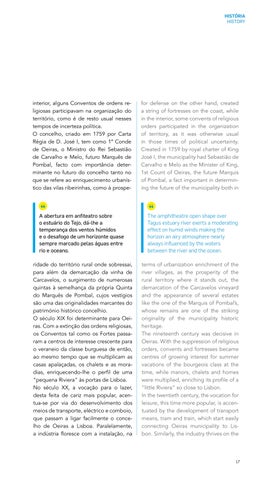HISTÓRIA HISTORY
interior, alguns Conventos de ordens religiosas participavam na organização do território, como é de resto usual nesses tempos de incerteza política. O concelho, criado em 1759 por Carta Régia de D. José I, tem como 1º Conde de Oeiras, o Ministro do Rei Sebastião de Carvalho e Melo, futuro Marquês de Pombal, facto com importância determinante no futuro do concelho tanto no que se refere ao enriquecimento urbanístico das vilas ribeirinhas, como à prospe-
for defense on the other hand, created a string of fortresses on the coast, while in the interior, some convents of religious orders participated in the organization of territory, as it was otherwise usual in those times of political uncertainty. Created in 1759 by royal charter of King José I, the municipality had Sebastião de Carvalho e Melo as the Minister of King, 1st Count of Oeiras, the future Marquis of Pombal, a fact important in determining the future of the municipality both in
A abertura em anfiteatro sobre o estuário do Tejo, dá-lhe a temperança dos ventos húmidos e o desafogo de um horizonte quase sempre marcado pelas águas entre rio e oceano.
The amphitheatre open shape over Tagus estuary river exerts a moderating effect on humid winds making the horizon an airy atmosphere nearly always influenced by the waters between the river and the ocean.
ridade do território rural onde sobressai, para além da demarcação da vinha de Carcavelos, o surgimento de numerosas quintas à semelhança da própria Quinta do Marquês de Pombal, cujos vestígios são uma das originalidades marcantes do património histórico concelhio. O século XIX foi determinante para Oeiras. Com a extinção das ordens religiosas, os Conventos tal como os Fortes passaram a centros de interesse crescente para o veraneio da classe burguesa de então, ao mesmo tempo que se multiplicam as casas apalaçadas, os chalets e as moradias, enriquecendo-lhe o perfil de uma “pequena Riviera” às portas de Lisboa. No século XX, a vocação para o lazer, desta feita de cariz mais popular, acentua-se por via do desenvolvimento dos meios de transporte, eléctrico e comboio, que passam a ligar facilmente o concelho de Oeiras a Lisboa. Paralelamente, a indústria floresce com a instalação, na
terms of urbanization enrichment of the river villages, as the prosperity of the rural territory where it stands out, the demarcation of the Carcavelos vineyard and the appearance of several estates like the one of the Marquis of Pombal’s, whose remains are one of the striking originality of the municipality historic heritage. The nineteenth century was decisive in Oeiras. With the suppression of religious orders, convents and fortresses became centres of growing interest for summer vacations of the bourgeois class at the time, while manors, chalets and homes were multiplied, enriching its profile of a “little Riviera” so close to Lisbon. In the twentieth century, the vocation for leisure, this time more popular, is accentuated by the development of transport means, tram and train, which start easily connecting Oeiras municipality to Lisbon. Similarly, the industry thrives on the
17
